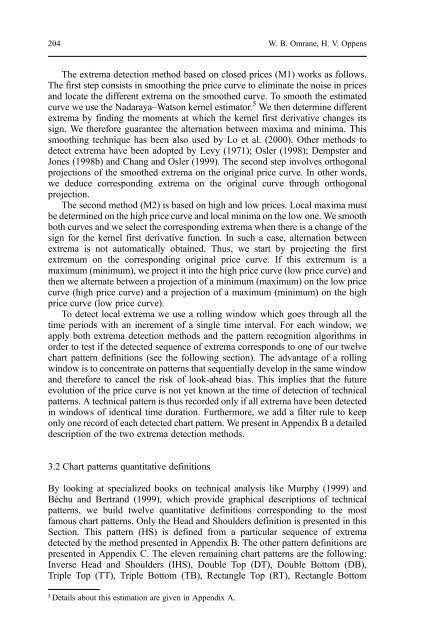recent developments in high frequency financial ... - Index of
recent developments in high frequency financial ... - Index of
recent developments in high frequency financial ... - Index of
You also want an ePaper? Increase the reach of your titles
YUMPU automatically turns print PDFs into web optimized ePapers that Google loves.
204<br />
The extrema detection method based on closed prices (M1) works as follows.<br />
The first step consists <strong>in</strong> smooth<strong>in</strong>g the price curve to elim<strong>in</strong>ate the noise <strong>in</strong> prices<br />
and locate the different extrema on the smoothed curve. To smooth the estimated<br />
curve we use the Nadaraya–Watson kernel estimator. 5 We then determ<strong>in</strong>e different<br />
extrema by f<strong>in</strong>d<strong>in</strong>g the moments at which the kernel first derivative changes its<br />
sign. We therefore guarantee the alternation between maxima and m<strong>in</strong>ima. This<br />
smooth<strong>in</strong>g technique has been also used by Lo et al. (2000). Other methods to<br />
detect extrema have been adopted by Levy (1971); Osler (1998); Dempster and<br />
Jones (1998b) and Chang and Osler (1999). The second step <strong>in</strong>volves orthogonal<br />
projections <strong>of</strong> the smoothed extrema on the orig<strong>in</strong>al price curve. In other words,<br />
we deduce correspond<strong>in</strong>g extrema on the orig<strong>in</strong>al curve through orthogonal<br />
projection.<br />
The second method (M2) is based on <strong>high</strong> and low prices. Local maxima must<br />
be determ<strong>in</strong>ed on the <strong>high</strong> price curve and local m<strong>in</strong>ima on the low one. We smooth<br />
both curves and we select the correspond<strong>in</strong>g extrema when there is a change <strong>of</strong> the<br />
sign for the kernel first derivative function. In such a case, alternation between<br />
extrema is not automatically obta<strong>in</strong>ed. Thus, we start by project<strong>in</strong>g the first<br />
extremum on the correspond<strong>in</strong>g orig<strong>in</strong>al price curve. If this extremum is a<br />
maximum (m<strong>in</strong>imum), we project it <strong>in</strong>to the <strong>high</strong> price curve (low price curve) and<br />
then we alternate between a projection <strong>of</strong> a m<strong>in</strong>imum (maximum) on the low price<br />
curve (<strong>high</strong> price curve) and a projection <strong>of</strong> a maximum (m<strong>in</strong>imum) on the <strong>high</strong><br />
price curve (low price curve).<br />
To detect local extrema we use a roll<strong>in</strong>g w<strong>in</strong>dow which goes through all the<br />
time periods with an <strong>in</strong>crement <strong>of</strong> a s<strong>in</strong>gle time <strong>in</strong>terval. For each w<strong>in</strong>dow, we<br />
apply both extrema detection methods and the pattern recognition algorithms <strong>in</strong><br />
order to test if the detected sequence <strong>of</strong> extrema corresponds to one <strong>of</strong> our twelve<br />
chart pattern def<strong>in</strong>itions (see the follow<strong>in</strong>g section). The advantage <strong>of</strong> a roll<strong>in</strong>g<br />
w<strong>in</strong>dow is to concentrate on patterns that sequentially develop <strong>in</strong> the same w<strong>in</strong>dow<br />
and therefore to cancel the risk <strong>of</strong> look-ahead bias. This implies that the future<br />
evolution <strong>of</strong> the price curve is not yet known at the time <strong>of</strong> detection <strong>of</strong> technical<br />
patterns. A technical pattern is thus recorded only if all extrema have been detected<br />
<strong>in</strong> w<strong>in</strong>dows <strong>of</strong> identical time duration. Furthermore, we add a filter rule to keep<br />
only one record <strong>of</strong> each detected chart pattern. We present <strong>in</strong> Appendix B a detailed<br />
description <strong>of</strong> the two extrema detection methods.<br />
3.2 Chart patterns quantitative def<strong>in</strong>itions<br />
By look<strong>in</strong>g at specialized books on technical analysis like Murphy (1999) and<br />
Béchu and Bertrand (1999), which provide graphical descriptions <strong>of</strong> technical<br />
patterns, we build twelve quantitative def<strong>in</strong>itions correspond<strong>in</strong>g to the most<br />
famous chart patterns. Only the Head and Shoulders def<strong>in</strong>ition is presented <strong>in</strong> this<br />
Section. This pattern (HS) is def<strong>in</strong>ed from a particular sequence <strong>of</strong> extrema<br />
detected by the method presented <strong>in</strong> Appendix B. The other pattern def<strong>in</strong>itions are<br />
presented <strong>in</strong> Appendix C. The eleven rema<strong>in</strong><strong>in</strong>g chart patterns are the follow<strong>in</strong>g:<br />
Inverse Head and Shoulders (IHS), Double Top (DT), Double Bottom (DB),<br />
Triple Top (TT), Triple Bottom (TB), Rectangle Top (RT), Rectangle Bottom<br />
5 Details about this estimation are given <strong>in</strong> Appendix A.<br />
W. B. Omrane, H. V. Oppens










